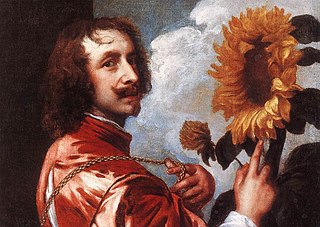
Sir Anthony van Dyck was a Flemish Baroque artist who became the leading court painter in England after success in the Spanish Netherlands and Italy.
Samson and Delilah are Biblical figures.
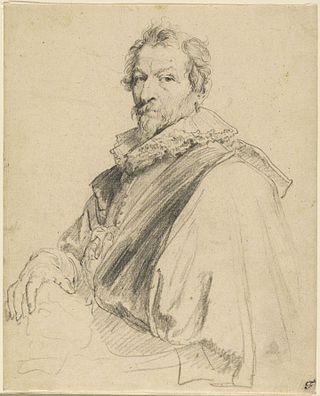
Hendrick van Balen or Hendrick van Balen I was a Flemish Baroque painter and stained glass designer. Hendrick van Balen specialised in small cabinet pictures often painted on a copper support. His favourite themes were mythological and allegorical scenes and, to a lesser extent, religious subjects. The artist played an important role in the renewal of Flemish painting in the early 17th century and was one of the teachers of Anthony van Dyck.

The Massacre of the Innocents is the subject of two paintings by Peter Paul Rubens depicting the episode of the biblical Massacre of the Innocents of Bethlehem, as related in the Gospel of Matthew (2:13-18). The first, measuring 142 x 182 cm, was painted after his return to his native Antwerp in 1608, following eight years spent in Italy.
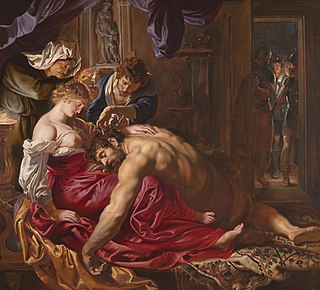
Samson and Delilah is a painting long attributed to the Flemish Baroque painter Peter Paul Rubens (1577–1640) and displayed in the National Gallery. It dates from about 1609 to 1610.

Lucas Franchoys the Younger or Lucas Franchoys II was a Flemish Baroque painter from Mechelen, who painted numerous altarpieces and portraits in a style reminiscent of Anthony van Dyck.
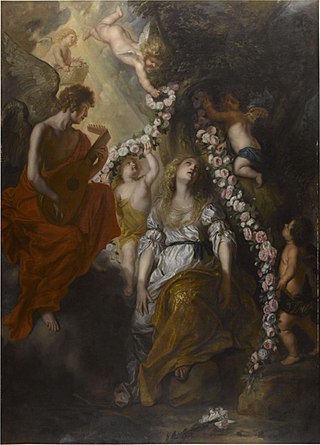
Theodoor Boeyermans, Theodor Boeyermans or Theodor Boeijermans was a Flemish painter active in Antwerp who painted Baroque history paintings and group portraits informed by the tradition of Peter Paul Rubens and Anthony van Dyck.

Isabella Brant was the first wife of the Flemish painter Peter Paul Rubens, who painted several portraits of her.
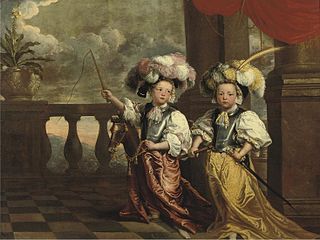
Johanna Vergouwen was a Flemish Baroque painter and copyist.
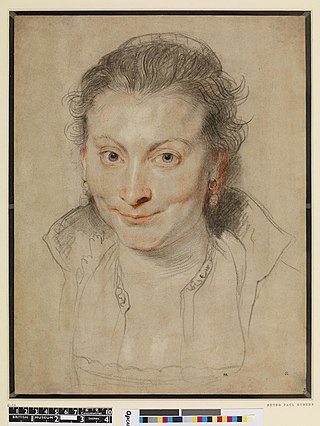
Isabella Brant,a portrait drawing, was executed in Antwerp around 1621, by Flemish artist and diplomat, Peter Paul Rubens (1577–1640). Brant (1591–1626) was Rubens' first wife and modelled for some of his portraits until her untimely death in 1626. The portrait is drawn in black and red chalk with white heightening on brown wash paper.

Cornelis van der Geest was a spice merchant from Antwerp, who used his wealth to support the Antwerp artists and to establish his art collection. He was also the dean of the haberdashers guild.

Theodosius and Saint Ambrose is a painting by Peter Paul Rubens, with assistance from his main pupil Anthony van Dyck, executed c. 1615–1616. It is now in the Kunsthistorisches Museum in Vienna. Rubens created the preparatory drawing, with the painting almost entirely done by van Dyck, who painted his own similar version of the subject a few years later. In the Rubens version, the architectural background is less defined, Theodosius is bearded and the spear and halberd in van Dyck's own version are omitted.

The Vision of the Blessed Hermann Joseph or The Mystical Engagement of the Blessed Hermann Joseph to the Virgin Mary is a 1629-1630 painting by the Flemish Baroque painter Anthony van Dyck.

Crucifixion with the Virgin Mary, St John and St Mary Magdalene is a painting by Anthony van Dyck. He produced it in 1617-19 as the high altarpiece for the Jesuit church in Bergues, near Dunkirk, during his time as an assistant painter to Peter Paul Rubens - for a long time the painting was even attributed to Rubens. It was paid to Rubens in 1621 and seems to have been sold around 1746. It was bought by Louis XV of France in Antwerp in 1749 to be the high altarpiece of Saint-Louis de Versailles at the Palace of Versailles. It is now in the Louvre, in Paris.

The Crowning with Thorns is a 1618–1620 painting by Anthony van Dyck. He produced it aged 20 during his first Antwerp period, when he was the main studio assistant and pupil of Peter Paul Rubens. It shows Rubens' influence in its relatively sombre palette, chiaroscuro and highly realistic portrayal of musculature. He seems to have completed it early during his stay in Italy, since it also shows the influence of Titian and other Venetian painters in Jesus' face.

Samson and Delilah is a 1620 painting by Anthony van Dyck.It was heavily inspired by his tutor Rubens's version of the same subject and for a long time was attributed to Rubens. Van Dyck inverted the composition and showed Delilah in white chalk make-up and heavily rouged cheeks, the makeup traditionally worn by Parisian prostitutes. The painting is now held in the Dulwich Picture Gallery in London. He returned to the subject in 1630.

Cupid and Psyche is an oil on canvas painting by Anthony van Dyck. It is now in the Royal Collection and shown in Kensington Palace.

Madonna and Child is a 1621–1627 painting by Anthony van Dyck, now in the Galleria nazionale di Parma.

St Martin Dividing his Cloak is a painting by the Flemish painter Anthony van Dyck dated around 1618, which is an altarpiece in the Sint-Martinuskerk in Zaventem, Belgium. The painting portrays the story of Saint Martin sharing his cloak with a beggar. This early work of van Dyck was painted when he was strongly influenced by Rubens's style.

Nicolaas Rockox (1560–1640), was a mayor of Antwerp. He was a close personal friend and important patron of Peter Paul Rubens. His residence in Antwerp is now a museum known as the Rockox House. He was knighted by Archduke Albert and Isabella, the Governor General of the Southern Netherlands.





















